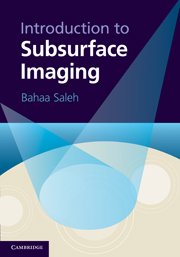Book contents
- Frontmatter
- Contents
- Authors and Contributors
- Preface
- Acknowledgements
- Outline and Roadmap
- 1 Overview
- 2 Physical Models
- 3 Localized Imaging
- 4 Tomographic Imaging
- 5 Digital Image Processing
- 6 Spectral Imaging
- 7 Mosaicing, Change Detection, and Multisensor Imaging
- 8 Numerical Simulation
- 9 Design of Subsurface Imaging Systems
- A Multi-Dimensional Signals and Systems
- B Linear Algebra
- C Detection and Classification
- D Software Tools
- Index
7 - Mosaicing, Change Detection, and Multisensor Imaging
Published online by Cambridge University Press: 05 June 2012
- Frontmatter
- Contents
- Authors and Contributors
- Preface
- Acknowledgements
- Outline and Roadmap
- 1 Overview
- 2 Physical Models
- 3 Localized Imaging
- 4 Tomographic Imaging
- 5 Digital Image Processing
- 6 Spectral Imaging
- 7 Mosaicing, Change Detection, and Multisensor Imaging
- 8 Numerical Simulation
- 9 Design of Subsurface Imaging Systems
- A Multi-Dimensional Signals and Systems
- B Linear Algebra
- C Detection and Classification
- D Software Tools
- Index
Summary
It is sometimes desired to capture a high-resolution image of a large object by use of an imaging system with adequate resolution but insufficient number of pixels/voxels. This can be accomplished by taking multiple images of smaller segments of the object and subsequently collating them into a single image. In other applications, multiple images of a single object are obtained by use of different imaging modalities or technologies. The extraction of meaningful information on the object from such multiple images can be challenging. In yet other applications, an object is imaged with the same instrument before and after some change has occurred and the two images are to be compared to assess the change. Dealing with multiple images is an important task that requires precise alignment often under uncertain conditions.
This chapter describes a set of related techniques that involve multiple images. First, mosaicing is the stitching together of multiple partial views of a region that is much larger than the field of view of the imaging instrument, into a single large synthetic image of the entire region. Second, multisensor fusion is the combination of images of the same region acquired by two or more imaging modalities, e.g., optical and ultrasonic. Third, change detection is the identification of changes occurring in a sequence of images of the same region. Underlying these three important applications is the need for image registration – a method for accurately aligning multiple images, and transforming them into a common coordinate frame.
- Type
- Chapter
- Information
- Introduction to Subsurface Imaging , pp. 276 - 322Publisher: Cambridge University PressPrint publication year: 2011



